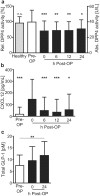Reduced post-operative DPP4 activity associated with worse patient outcome after cardiac surgery
- PMID: 30087386
- PMCID: PMC6081383
- DOI: 10.1038/s41598-018-30235-w
Reduced post-operative DPP4 activity associated with worse patient outcome after cardiac surgery
Abstract
Cardiac surgery with cardiopulmonary bypass (CPB) triggers myocardial ischemia/reperfusion injury contributing to organ dysfunction. Preclinical studies revealed that dipeptidyl peptidase (DPP4) inhibition is protective during myocardial infarction. Here, we assessed for the first time the relation of peri-operative DPP4-activity in serum of 46 patients undergoing cardiac surgery with patients' post-operative organ dysfunction during intensive care unit (ICU) stay. Whereas a prior myocardial infarction significantly reduced pre-operative DDP4-activity, patients with preserved left ventricular function showed an intra-operative decrease of DPP4-activity. The latter correlated with aortic cross clamping time, indicative for the duration of surgery-induced myocardial ischemia. As underlying mechanism, mass-spectrometry revealed increased DPP4 oxidation by cardiac surgery, with DPP4 oxidation reducing DPP4-activity in vitro. Further, post-operative DPP4-activity was negatively correlated with the extent of post-operative organ injury as measured by SAPS II and SOFA scoring, circulating levels of creatinine and lactate, as well as patients' stay on the ICU. In conclusion, cardiac surgery reduces DPP4-activity through oxidation, with low post-operative DPP4-activity being associated with organ dysfunction and worse outcome of patients during the post-operative ICU stay. This likely reflects the severity of myocardial ischemia/reperfusion injury and may suggest potential beneficial effects of anti-oxidative treatments during cardiac surgery.
Conflict of interest statement
The authors declare no competing interests.
Figures







References
-
- World health statistics 2017: monitoring health for the SDGs, Sustainable Development Goals. Geneva: World Health Organization; Licence: CC BY-NC-SA3.0 IGO (2017).
-
- World Health Organization. Fact sheet Cardiovascular diseases (CVDs) (2017).
-
- International Diabetes Federation. IDF Diabetes Atlas. Seventh Edition (2015).
Publication types
MeSH terms
Substances
Grants and funding
- DFG SFB/TRR219-M05/Deutsche Forschungsgemeinschaft (German Research Foundation)/International
- DFG SFB/TRR219-S03/Deutsche Forschungsgemeinschaft (German Research Foundation)/International
- DFG SFB/TRR219-M03/Deutsche Forschungsgemeinschaft (German Research Foundation)/International
- DFG SFB/TRR219-M03 and M-05/Deutsche Forschungsgemeinschaft (German Research Foundation)/International
- DFG SFB/TRR219-S03/Deutsche Forschungsgemeinschaft (German Research Foundation)/International
LinkOut - more resources
Full Text Sources
Other Literature Sources
Medical
Research Materials
Miscellaneous

